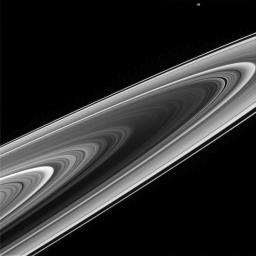
|
What’s That Speck?
- Click the image above for a larger view
- Full-Res JPEG (1024 x 1024) (69.6 kB)
- Full-Res TIFF (1024 x 1024) (1.1 MB)
Caption:
Cassini's climb to progressively higher elevations reveals the "negative" side of Saturn's rings. As the Sun shines through the rings, they take on the appearance of a photonegative: the dense B ring (at the center) blocks much of the incoming light, while the less dense regions scatter and transmit light.
Close inspection reveals not one, but two moons in this scene. Mimas (397 kilometers, or 247 miles across) is easily visible near the upper right, but the shepherd moon Prometheus (102 kilometers, or 63 miles across) can also be seen. Prometheus is a dark spot against the far side of the thin, bright F ring. Most of Prometheus' sunlit side is turned away from Cassini in this view.
The image was taken in visible light with the Cassini spacecraft wide-angle camera on April 15, 2005, at a distance of approximately 570,000 kilometers (350,000 miles) from Saturn. The image scale is 30 kilometers (19 miles) per pixel.
Background Info:
The Cassini-Huygens mission is a cooperative project of NASA, the European Space Agency and the Italian Space Agency. The Jet Propulsion Laboratory, a division of the California Institute of Technology in Pasadena, manages the mission for NASA's Science Mission Directorate, Washington, D.C. The Cassini orbiter and its two onboard cameras were designed, developed and assembled at JPL. The imaging team is based at the Space Science Institute, Boulder, Colo.
For more information about the Cassini-Huygens mission visit http://saturn.jpl.nasa.gov . For additional images visit the Cassini imaging team homepage http://ciclops.org .
Cataloging Keywords:
| Name | Value | Additional Values |
|---|---|---|
| Target | Saturn Rings | B Ring, Mimas, Prometheus, Saturn |
| System | Saturn | |
| Target Type | Ring | Planet, Satellite |
| Mission | Cassini-Huygens | |
| Instrument Host | Cassini Orbiter | |
| Host Type | Orbiter | |
| Instrument | Imaging Science Subsystem (ISS) | |
| Detector | Wide Angle Camera | |
| Extra Keywords | Atmosphere, Grayscale, Storm, Visual | |
| Acquisition Date | ||
| Release Date | 2005-06-14 | |
| Date in Caption | 2005-04-15 | |
| Image Credit | NASA/JPL/Space Science Institute | |
| Source | photojournal.jpl.nasa.gov/catalog/PIA07520 | |
| Identifier | PIA07520 | |
